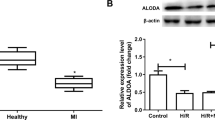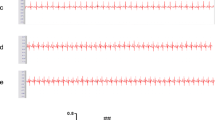Abstract
Overproduction of circulating S100A8/A9 occurs in patients following acute myocardial infarction (AMI). It remains unclear whether ischemia insult per se induces S100A8 and S100A9 expression in cardiac myocytes or even whether the cardiac myocytes participate as a source of these proteins. In this study, western blot analysis and quantitative real-time reverse transcription polymerase chain reaction were used to test samples obtained from isolated spontaneously hypertensive rat hearts and Wistar-Kyoto rat hearts subjected to global normothermic ischemia and from neonatal Wistar rat cardiac myocytes undergoing hypoxia. Ischemia did not increase the expression of S100A8 and S100A9 proteins and mRNA in the myocardium either from the spontaneously hypertensive rat hearts or the Wistar-Kyoto rat hearts. In addition, the levels of S100A8 and S100A9 proteins were unchanged in the neonatal rat cardiac myocytes undergoing hypoxia. However, both ischemia and hypoxia activated NF-kappaB in ischemic myocardium and in hypoxic cardiac cells in a time-dependent manner. The results suggest that the increased serum S100A8/A9 concentrations following AMI were not of cardiac myocyte origin.




Similar content being viewed by others
Abbreviations
- ACS:
-
Acute coronary syndrome
- AMI:
-
Acute myocardial infarction
- SHR:
-
Spontaneously hypertensive rats
- WKY:
-
Wistar-Kyoto rats
- PBS:
-
Phosphate-buffered saline
- LVEDP:
-
Left ventricular end-diastolic pressure
- LVDP:
-
Left ventricular developed pressure
- GAPDH:
-
Glyceraldehyde-3-phosphate dehydrogenase
- RT-qPCR:
-
Quantitative real-time reverse transcription polymerase chain reaction
- LPS:
-
Lipopolysaccharide
- PMN:
-
Polymorphonuclear leukocytes
- IL-1β:
-
Interleukin-1 beta
- TNF-α:
-
Tumor necrosis factor alpha
- IL-1α:
-
Interleukin-1 alpha
- TGF-β:
-
Transforming growth factor beta
- RAGE:
-
Receptor for advanced glycosylation end products
References
Teigelkamp, S., R.S. Bhardwaj, J. Roth, G. Meinardus-Hager, M. Karas, and C. Sorg. 1991. Calcium-dependent complex assembly of the myeloic differentiation proteins MRP-8 and MRP-14. Journal of Biological Chemistry 266: 13462–13467.
Foell, D., M. Frosch, C. Sorg, and J. Roth. 2004. Phagocyte-specific calcium-binding S100 proteins as clinical laboratory markers of inflammation. Clinica Chimica Acta 344: 37–51.
Striz, I., and I. Trebichavsky. 2004. Calprotectin: a pleiotropic molecule in acute and chronic inflammation. Physiological Research 53: 245–253.
Vogl, T., K. Tenbrock, S. Ludwig, N. Leukert, C. Ehrhardt, M.A. van Zoelen, et al. 2007. Mrp8 and Mrp14 are endogenous activators of Toll-like receptor 4, promoting lethal, endotoxin-induced shock. Nature Medicine 13: 1042–1049.
Ehrchen, J.M., C. Sunderkötter, D. Foell, T. Vogl, and J. Roth. 2009. The endogenous Toll-like receptor 4 agonist S100A8/S100A9 (calprotectin) as innate amplifier of infection, autoimmunity, and cancer. Journal of Leukocyte Biology 86: 557–566.
Morrow, D.A., Y. Wang, K. Croce, M. Sakuma, M.S. Sabatine, H. Gao, et al. 2008. Myeloid-related protein-8/14 and the risk of cardiovascular death or myocardial infarction after an acute coronary syndrome in the PROVE IT-TIMI 22 Trial. American Heart Journal 155: 49–55.
Healy, A.M., M.D. Pickard, A.D. Pradhan, Y. Wang, Z. Chen, K. Croce, et al. 2006. Platelet expression profiling and clinical validation of myeloid-related protein-14 as a novel determinant of cardiovascular events. Circulation 113: 2278–2284.
Altwegg, L.A., M. Neidhart, M. Hersberger, S. Müller, F.R. Eberli, R. Corti, et al. 2007. Myeloid-related protein 8/14 complex is released by monocytes and granulocytes at the site of coronary occlusion: a novel, early, and sensitive marker of acute coronary syndromes. European Heart Journal 28: 941–948.
Miyamoto, S., M. Ueda, M. Ikemoto, T. Naruko, A. Itoh, S. Tamaki, et al. 2008. Increased serum levels and expression of S100A8/A9 complex in infiltrated neutrophils in atherosclerotic plaque of unstable angina. Heart 94: 1002–1007.
Katashima, T., T. Naruko, F. Terasaki, M. Fujita, K. Otsuka, S. Murakami, et al. 2010. Enhanced expression of the S100A8/A9 complex in acute myocardial infarction patients. Circulation Journal 74: 741–748.
McCormick, M.M., F. Rahimi, Y.V. Bobryshev, K. Gaus, H. Zreiqat, H. Cai, et al. 2005. S100A8 and S100A9 in human arterial wall: Implications for atherogenesis. Journal of Biological Chemistry 280: 41521–41529.
Mues, B., B. Brisse, G. Zwadlo, H. Themann, F. Bender, and C. Sorg. 1990. Phenotyping of macrophages with monoclonal antibodies in endomyocardial biopsies as a new approach to diagnosis of myocarditis. European Heart Journal 11: 619–627.
Boyd, J.H., B. Kan, H. Roberts, Y. Wang, and K.R. Walley. 2008. S100A8 and S100A9 mediate endotoxin-induced cardiomyocyte dysfunction via the receptor for advanced glycation end products. Circulation Research 102: 1239–1246.
Bouma, G., W.K. Lam-Tse, A.F. Wierenga-Wolf, H.A. Drexhage, and M.A. Versnel. 2004. Increased serum levels of MRP-8/14 in type 1 diabetes induce an increased expression of CD11b and an enhanced adhesion of circulating monocytes to fibronectin. Diabetes 53: 1979–1986.
Semb, A.G., T.O. Gabrielsen, T.S. Halstensen, M.K. Fagerhol, P. Brandtzaeg, and J. Vaage. 1991. Cardiac surgery and distribution of the leukocyte Ll protein-calprotectin. European Journal of Cardio-Thoracic Surgery 5: 363–367.
Neumann, F.J., I. Ott, M. Gawaz, G. Richardt, H. Holzapfel, M. Jochum, et al. 1995. Cardiac release of cytokines and inflammatory responses in acute myocardial infarction. Circulation 92: 748–755.
Edgeworth, J., M. Gorman, R. Bennett, P. Freemont, and N. Hogg. 1991. Identification of p8,14 as a highly abundant heterodimeric calcium binding protein complex of myeloid cells. Journal of Biological Chemistry 266: 7706–7713.
Inaba, H., K. Hokamura, K. Nakano, R. Nomura, K. Katayama, A. Nakajima, et al. 2009. Upregulation of S100 calcium-binding protein A9 is required for induction of smooth muscle cell proliferation by a periodontal pathogen H. FEBS Letters 583: 128–134.
Rahimi, F., K. Hsu, Y. Endoh, and C.L. Geczy. 2005. FGF-2, IL-1b and TGF-b regulate fibroblast expression of S100A8. FEBS Journal 272: 2811–2827.
Nishikimi, T., H. Yamagishi, K. Takeuchi, and T. Takeda. 1995. An angiotensin II receptor antagonist attenuates left ventricular dilatation after myocardial infarction in the hypertensive rat. Cardiovascular Research 29: 856–861.
Kodavanti, U.P., M.C. Schladweiler, A.D. Ledbetter, W.P. Watkinson, M.J. Campen, D.W. Winsett, et al. 2000. The spontaneously hypertensive rat as a model of human cardiovascular disease: evidence of exacerbated cardiopulmonary injury and oxidative stress from inhaled emission particulate matter. Toxicology and Applied Pharmacology 164: 250–263.
Kubota, Y., K. Umegaki, S. Kagota, N. Tanaka, K. Nakamura, M. Kunitomo, et al. 2006. Evaluation of blood pressure measured by tail-cuff methods (without heating) in spontaneously hypertensive rats. Biological and Pharmaceutical Bulletin 29: 1756–1758.
Yang, Y., S.J. Hu, L. Li, and G.P. Chen. 2009. Cardioprotection by polysaccharide sulfate against ischemia/reperfusion injury in isolated rat hearts. Acta Pharmacologica Sinica 30: 54–60.
Ye, Y., S.J. Hu, and L. Li. 2009. Inhibition of farnesylpyrophosphate synthase prevents angiotensin II-induced hypertrophic responses in rat neonatal cardiomyocytes: involvement of the RhoA/Rho kinase pathway. FEBS Letters 583: 2997–3003.
Kacimi, R., C.S. Long, and J.S. Karliner. 1997. Chronic hypoxia modulates IL-1binduced nitric oxide synthase signaling in neonatal ventricular myocytes. Circulation 96: 1937–1943.
Hermani, A., B. De Servi, S. Medunjanin, P.A. Tessier, and D. Mayer. 2006. S100A8 and S100A9 activate MAP kinase and NF-kappaB signaling pathways and trigger translocation of RAGE in human prostate cancer cells. Experimental Cell Research 312: 184–197.
Simkhovich, B.Z., P. Marjoram, C. Poizat, L. Kedes, and R.A. Kloner. 2003. Brief episode of ischemia activates protective genetic program in rat heart: A gene chip study. Cardiovascular Research 59: 450–459.
Ionita, M.G., A. Vink, I.E. Dijke, J.D. Laman, W. Peeters, P.H. van der Kraak, et al. 2009. High levels of myeloid-related protein 14 in human atherosclerotic plaques correlate with the characteristics of rupture-prone lesions. Arteriosclerosis, Thrombosis, and Vascular Biology 29: 1220–1227.
Djurdjevic, P.M., N.N. Arsenijevic, D.D. Baskic, A.L. Djukic, S. Popovic, and G. Samardzic. 2001. Systemic response of peripheral blood leukocytes and their phagocytic activity during acute myocardial infarction. Experimental and Clinical Cardiology 6: 159–166.
Goyette, J., and C.L. Geczy. 2011. Inflammation-associated S100 proteins: new mechanisms that regulate function. Amino Acids (in press).
Ross, K.F., and M.C. Herzberg. 2001. Calprotectin expression by gingival epithelial cells. Infection and Immunity 69: 3248–3254.
Bando, M., Y. Hiroshima, M. Kataoka, Y. Shinohara, M.C. Herzberg, K.F. Ross, et al. 2007. Interleukin-1alpha regulates antimicrobial peptide expression in human keratinocytes. Immunology and Cell Biology 85: 532–537.
Rammes, A., J. Roth, M. Goebeler, M. Klempt, M. Hartmann, and C. Sorg. 1997. Myeloid-related protein (MRP) 8 and MRP14, calcium-binding proteins of the S100 family, are secreted by activated monocytes via a novel, tubulin-dependent pathway. Journal of Biological Chemistry 272: 9496–9502.
Kido, J., N. Hayashi, M. Kataoka, and T. Nagata. 2005. Calprotectin expression in human monocytes: Induction by porphyromonas gingivalis lipopolysaccharide, tumor necrosis factor-alpha, and interleukin-1beta. Journal of Periodontology 76: 437–442.
Frosch, M., A. Strey, T. Vogl, N.M. Wulffraat, W. Kuis, C. Sunderkötter, et al. 2000. Myeloid-related proteins 8 and 14 are specifically secreted during interaction of phagocytes and activated endothelium and are useful markers for monitoring disease activity in pauciarticular-onset juvenile rheumatoid arthritis. Arthritis and Rheumatism 43: 628–637.
Hsu, K., C. Champaiboon, B.D. Guenther, B.S. Sorenson, A. Khammanivong, K.F. Ross, et al. 2009. Anti-infective protective properties of S100 calgranulins. Antiinflamm Antiallergy Agents Med Chem 8: 290–305.
Alexander, R.W. 1994. Inflammation and coronary artery disease. The New England Journal of Medicine 331: 468–469.
Nian, M., P. Lee, N. Khaper, and P. Liu. 2004. Inflammatory cytokines and post-myocardial infarction remodeling. Circulation Research 94: 1543–1553.
Cain, B.S., D.R. Meldrum, C.A. Dinarello, X. Meng, K.S. Joo, A. Banerjeeet, et al. 1999. Tumor necrosis factor-alpha and interleukin-1beta synergistically depress human myocardial function. Critical Care Medicine 27: 1309–1318.
Nacken, W., J. Roth, C. Sorg, and C. Kerkhoff. 2003. S100A9/S100A8: Myeloid representatives of the S100 protein family as prominent players in innate immunity. Micros Res Tech 60: 569–580.
Carroccio, A., P. Rocco, P.G. Rabitti, L. Di Prima, G.B. Forte, and A.B. Cefalu. 2006. Plasma calprotectin levels in patients suffering from acute pancreatitis. Digestive Diseases and Sciences 51: 1749–1753.
Homann, C., E. Christensen, P. Schlichting, E.K. Philipsen, N.A. Graudal, and P. Garred. 2003. Ascites fluid and plasma calprotectin concentrations in liver disease. Scandinavian Journal of Gastroenterology 38: 415–420.
Shames, B.D., H.H. Barton, L.L. Reznikov, C.B. Cairns, A. Banerjee, A.H. Harken, et al. 2002. Ischemia alone is sufficient to induce TNF-alpha mRNA and peptide in the myocardium. Shock 17: 114–119.
Kacimi, R., J.S. Karliner, F. Koudssi, and C.S. Long. 1998. Expression and regulation of adhesion molecules in cardiac cells: response to acute hypoxia. Circulation Research 82: 576–586.
Gupta, S., D. Young, and S. Sen. 2005. Inhibition of NF-kappaB induces regression of cardiac hypertrophy, independent of blood pressure control, in spontaneously hypertensive rats. American Journal of Physiology-Heart and Circulatory Physiology 289: H20–H29.
Gerhardt, W., and L. Ljungdahl. 1998. Troponin T: A sensitive and specific diagnostic and prognostic marker of myocardial damage. Clinica Chimica Acta 272: 47–57.
Sutherland, F.J., and D.J. Hearse. 2000. The isolated blood and perfusion fluid perfused heart. Pharmacological Research 41: 613–627.
Acknowledgments
This work was supported by the National Natural Sciences Foundation of China (project numbers 30470715, 30870939) and the Research Fund for the Doctoral Program of Higher Education of China (no. 20040335118).
Conflict of interest
The authors have no conflicting financial interests.
Author information
Authors and Affiliations
Corresponding author
Additional information
Chang-Qing Du and Lin Yang contributed equally to this work.
Rights and permissions
About this article
Cite this article
Du, CQ., Yang, L., Han, J. et al. The Elevated Serum S100A8/A9 During Acute Myocardial Infarction Is Not of Cardiac Myocyte Origin. Inflammation 35, 787–796 (2012). https://doi.org/10.1007/s10753-011-9375-8
Published:
Issue Date:
DOI: https://doi.org/10.1007/s10753-011-9375-8




